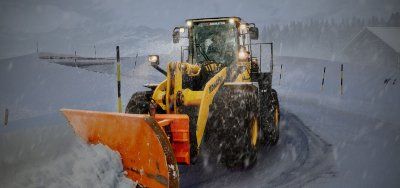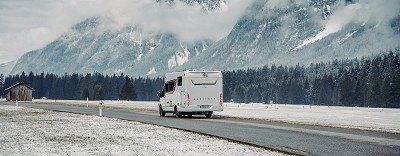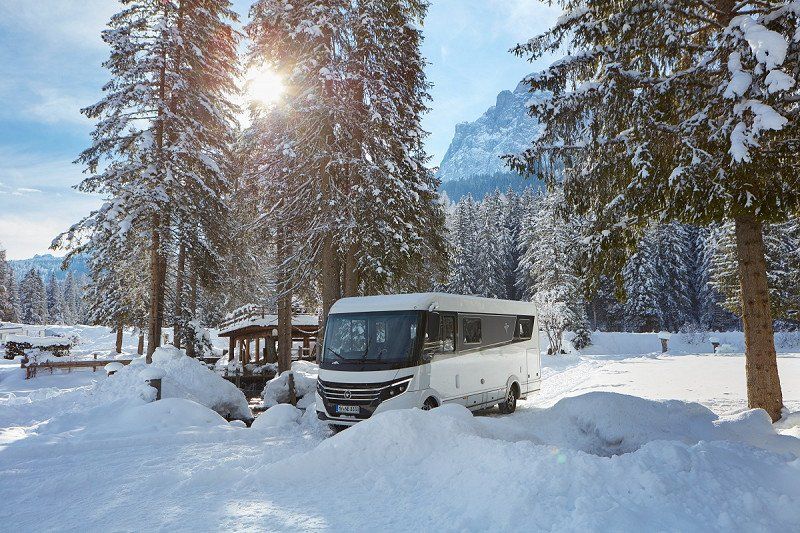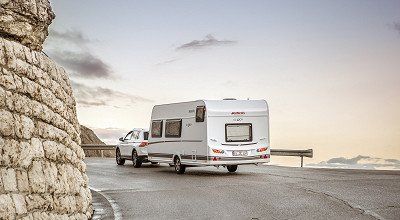Latest update: October 18, 2024
Whether you are new to caravanning or a seasoned camper – when travelling in winter with your motorhome, campervan or car/caravan combination you will be confronted with different situations in winter road conditions than in summer. Freeontour gives ten tips on how to get to your destination safely with a caravan or mobile home in winter.
Tip #1: Remove all snow and ice from the vehicle
You need to plan a little more time in winter before hitting the road because you will have to scrape snow and ice off the windows of your towing vehicle or motorhome, just like with a car. If you drive off with only a peephole in the windscreen, you not only risk a fine, but also endanger other road users. If you hate scraping snow and ice, place a thermal cover on the front window. However, should it snow, the entire vehicle or car/caravan combination will also have to be cleared of snow, including the headlights, number plates and roof.
In winter, it is always advisable to equip your camper with a broom with a telescopic handle and even a small stepladder to make it easier to clear those hard-to-reach places of snow on top of your mobile home or caravan. It is also worth considering a protective roof tarpaulin, at least for longer stays. Incidentally, you also risk getting a fine if you drive with snow-covered number plates, vehicle lights or snow on the roof. In some countries, you can also be penalised for driving without winter tyres in winter road conditions, not to mention the insurance implications.
Before setting off, you should also check or increase tyre pressure. In general, we recommend increasing the air pressure specified by the vehicle or tyre manufacturer by 0.2 bar in winter as tyre pressure drops slightly in cold temperatures.
Caravans: the tow-bar and drawbar also have to be completely de-iced in winter so that you can connect the caravan securely. You can also use caps and drawbar covers to protect them against the elements.
Tip #2: Test brakes before leaving & during the drive
When you first set off on your winter trip with your caravan or mobile home, you often have to get used to driving a heavy vehicle again. To get a feel for the vehicle and the road conditions, simply test the brakes after driving a few metres – provided that there are no other vehicles behind you. Traffic permitting, you should also test the brakes every now and then during the drive on a straight stretch, especially when the road conditions change. But please don't forget to look in the rearview mirror and make sure that no other vehicles are nearby.
Tip #3: Drive proactively and adapt your speed to the weather
This golden rule applies at all times and for all road users – but even more so in winter and for camping vehicles. Both car/caravan combinations and motorhomes have significantly more mass than a single car, which makes the braking distance noticeably longer in wet, snowy and slippery conditions than on a dry road in summer. Therefore, maintain a greater distance to other vehicles than usual in winter and always factor in the longer braking distance. When it comes to black ice, twice the distance compared to dry weather is recommended. Moreover, it is better to pull over to the right (or left, depending on which country you are in) from time to time to give faster vehicles the opportunity to overtake you rather than constantly tailgate you...
Tip #4: Engage the clutch carefully and brake early
Winter road conditions with snow and ice require particularly careful handling of the clutch and brake pedals to prevent the motorhome or car/caravan combination from swerving. Shift gears gently on slippery roads to avoid locking the wheels when you engage the clutch. Caution is also advised when turning onto a side street as it may not be cleared of snow or is more slippery than the main road. This also applies to driving on bridges as their road surface is always a few degrees colder than the rest of the road and will, therefore, easily freeze over. Curves, hairpin bends, intersections and the braking area in front of traffic lights can sometimes be more slippery and icier than other sections of the road, so you will have to brake earlier than you would in summer. In vehicles with an anti-lock braking system (ABS), you will need to apply the brake pedal firmly for the system to work. But if your vehicle does not have ABS, you will need to pump the brake pedal.
Tip #5: Gently accelerate and steer when the road is slippery
Anyone travelling on a slippery road with a motorhome or car/caravan combination should operate the accelerator very carefully and sensitively. If you accelerate too quickly or suddenly take your foot off the accelerator, the vehicle will swerve on a slippery road in no time at all. Avoid wearing winter shoes with extremely thick soles while sitting behind the wheel so as not to lose the feeling for the accelerator pedal.
Your driving behaviour needs to be just as sensitive when steering. The rule of thumb is: the more slippery the road, the less you steer. Jerky steering on a slippery road surface can cause the vehicle or car/caravan combination to skid. Therefore, move the steering wheel slowly when steering. Moreover, you quickly lose the feeling of the actual wheel positions on slippery surfaces.
Tip #6: Drive fast and steadily uphill
When driving uphill on snowy or slippery roads, it is important not to drive too fast or too slowly. We recommend driving fast and as steadily as possible to prevent the wheels from spinning. You can give a little more gas as winter tyres have a higher maximum wheelspin than summer tyres. Therefore, you get more propulsion on snow when the wheels turn a little faster than the actual speed would correspond to. If the road surface is very snowy, fitting snow chains is obviously the safest solution, which is why they should be in every camper's winter kit.
Incidentally, when driving uphill on black ice, you can also use the weight distribution in the vehicle to your advantage. Distribute as much weight as possible around the drive wheels. Should you have problems going uphill, place as much weight as possible at the front in front-wheel drive vehicles and as much weight as possible on the rear axle in rear-wheel drive vehicles. This tactic can also help when starting on a hill.
Tip #7: Use a low gear and engine braking on slopes
Steep slopes and lots of bends can stress out campers even when driving in summer road conditions, and even more so on icy or slippery roads. The ideal solution would be to take a break from driving your motorhome or car/caravan combination on black ice until the snow-clearing vehicles have done their job and the roads are easy to drive again.
However, if driving downhill on a slippery road surface cannot be avoided, use a low gear and engine braking as much as possible. This way, you will still be able to steer the vehicle and the wheels will not lock up. For car/caravan combinations, it is important to operate the wheel brakes smoothly on slopes. Therefore, make sure that the overrun damper and overrun device are working and adjusted correctly.

Tip #8: Start in second gear on slippery road surfaces
Starting your motorhome or car/caravan combination can also be difficult in snow and slippery conditions. Start in second gear to prevent the wheels from spinning or use the winter mode in automatic vehicles to increase traction on the road.
In general, driving at a low speed in a higher gear can make driving on slippery roads easier. When manoeuvring a caravan on a slippery surface, we also recommend uncoupling the caravan and pushing it manually or with a mover onto the parking space or area of the road with more grip.

Tip #9: Use aids and weight distribution if the camper gets stuck in the snow
It is always better to put snow chains on the drive wheels early on to prevent your mobile home or car/caravan combination from getting stuck in the snow in the first place as it is much more difficult to fit them in a snowdrift. However, you cannot completely rule it out even with snow chains on. Regardless of whether snow chains are on the wheels or not, if you do get stuck, it is essential to keep calm and not to accelerate uncontrollably.
If you step on the gas pedal now, you will most probably make the wheels spin and the track will become even more slippery. If your vehicle does get stuck, first place a traction aid under the drive wheels of your vehicle. Tyre traction aids from specialist stores are the best solution. If you do not have any at hand, you can improvise by placing some cardboard, a blanket, foot mats or twigs and branches under them. A folding shovel makes it easier to dig out the drive wheels to place the traction aids underneath. Incidentally, the front wheels on most modern campervans and mobile homes up to 3.5 t are the drive wheels.
The next step is to try to free the vehicle from the snowdrift in its own track as the latter usually has more grip than the loose snow on the sides. It could also help to place as much weight as possible on the drive axle – with front-wheel drive vehicles, you could just this once have all passengers "gather" in the driver's cab for the rescue operation or bring the heavy luggage from the motorhome's rear garage to the front.
Please note: if the axle or bottom panel of the vehicle is already in the snow, it will be almost impossible to free the motorhome on your own. In this case, you will need to contact a professional towing service.
In general, this also applies to stuck car/caravan combinations. However, the weight distribution to free the trailer is slightly different. If the towing vehicle has front-wheel drive, briefly shift as much weight as possible to behind the axle of the caravan to reduce the vertical load on the trailer coupling. This means that the front axle of the towing vehicle is more heavily loaded, in turn increasing the grip. However, if the towing vehicle has rear-wheel drive, place the weight in front of the caravan's axle to increase the pressure on the drive wheels. It would also help if all the passengers sat on the back seat of the towing vehicle.
Please note: it goes without saying that the altered weight distribution in the motorhome or car/caravan combination needs to be changed back as soon as the vehicle is freed from the snow. Incorrect weight distribution in a motorhome or caravan has an even greater impact on driving behaviour on icy and slippery roads than on dry roads.
Tip #10: Brake hard when swerving
If the car/caravan combination starts to swerve on a slippery road – or in general – there is only one thing you can do: slam the brakes and hold the steering wheel straight! Under no circumstances should you try to countersteer, especially on a slippery road surface. Incidentally, this approach also applies to bends should the trailer look like it might start to bounce.












